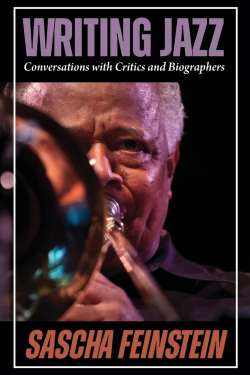“Liner Notes for ‘Stardust’ — In Seven Choruses” is a cycle of short poems framed as imaginary liner notes and prompted by poet Doug Fowler’s favorite musical covers of Hoagy Carmichael’s “Stardust.” In essence, according to Fowler, they are “imaginary liner notes for a real song about an imaginary song about love.”
The cycle is also partially a tribute to Chu Berry, who died as the result of a car accident in Conneaut, Ohio, in 1941, not far from where Fowler lives.
“LINER NOTES FOR ‘STARDUST’
— In Seven Choruses”
by Doug Fowler
*
“Star Dust” composed in 1927 by Hoagy Carmichael
Lyrics by Mitchell Parish added in 1929.
PRELUDE:
“Stardust” Chu Berry (with Roy Eldridge), 1938
Go!
the wild territorial blue and
watch out! over the
agricultural arc and frame. Look homeward
deep in a vein of rose quartz, colored as high
like watermelon snow.
Don’t make velocity a goal but savor the slow
concealed blues, even the dark line of storm
and let the aerial sift out lonely stations, waves
tuned and modulated to swing their lofted horns.
And I imagine what it might have been like
to play the car radio
driving
long and west
and up the line to the year I was born.
- “Star Dust” Louis Armstrong and his Orchestra, 1931 (Take 2)
Pulled off state route 177 where a macadam road
turns a sharp south on old survey lines where she
tells me to follow behind and into her blacktop drive.
Night thaws
and water drips
off ice-storm January trees
and in the late morning, Four Mile Creek, we
walk a path of 400 million years.
- “Star Dust” Louis Armstrong and his Orchestra, 1931 (Take 1)
I want so bad to apologize for it all –
my own name and
your ex’s
driven into space
and only dust returns.
Note on last stanza: Submitted
as short verse in the smallest careless
rockets, and the editor’s rejection, “I like this
but it couldn’t happen.”
It did.
As written.
A hundred thousand names
micro
etched
in silicon
orbit the Sun, reach aphelion
beyond Mars and into the asteroid expanse, 2.7 astronomical units.
[STARDUST Mission, 1999-2006, NASA/JPL COSPAR ID 1999-003A]
But a Mars colony with ATVs
corporate logos
and scoped rifles for polar bears?
I would ask to terraform the Earth.
I will keep the purple twilight, let wild violet asters
grow high
and once
I climbed along the Garden Wall arête walking the
luminous tiny blues of alpine forget-me-nots.
- “Stardust” Coleman Hawkins, 1937
Late humid summer red-ball sun
halfway down
on a Maumee valley
interstate
– the other half rises over Tannu Tuva
of triangle stamps
of mountains
of dream altitudes of
old prop airliners.
We pick up aluminum cans most anywhere
some 60 pounds a year
crushed flat and cashed in, I find
empty cans in a walk around a turnpike oasis, buy
burnt coffee, drive eastbound under an exit sign
Gibsonburg
Woodville
Elmore
like the three minerals in aluminum ore
Gibbsite
Boehmite
Diaspore.
How far back do libraries in small towns
keep old high school yearbooks?
Off on
U.S. 6 where
prairie turbine
generators rise in
windy blades
turning as smooth as
a midwest
cheerleader’s
cartwheels.
INTERLUDE: “Dizzy Atmosphere” Dizzy Gillespie (with Charlie Parker), 1945
Some towns are there
to remind us
of de Bergerac’s futility
killed by a fallen chunk of prairie oak
for lack of gardens
on balcony apartments
and Cyrano’s knocked out for good
despite his forgeries and ease with words.
- “Star Dust” Dizzy Gillespie Sextet, 1951
But who came to bed in the callous night?
Who brought these misty dreams
to bask in bellied heat?
My knees draw up to your knee-hollow tendons
conjoined with time
irreversible
persistent with an image of bright sun
washed red inside your eyelids
unavoidable
irresolution
down to the sea
in volcanic brines where purple stars
cling to the rocks in low-tides.
The jellies drift cold in northern harbors.
We walk the bridge west over a creek bed’s
Ordovician corals. We carry limestone
and hold up lampshells.
- “Stardust” Lester Young, 1956
(A. E. van Vogt reread after 35 years)
As light as being
and becoming
as light as rarefied air
a drift of stove-ash thrown to the wind off the
back of a bird, a single memory is helium gone
to lampblack, gone over to instability, a fading
luminosity once reclined in a pick-up camper,
down bags and snow-sealed boots, sun slides
over second-hand paperback pages, turning
with every switchback ascent from Red Lodge,
climbing a warm chant, a polyphony around our
tiny mass, redemption for the lost heat of fifty
yellow suns off in the Magellanic Clouds
and not all that far west.
- “Stardust” Joshua Redman, 2012
a goof
–that’s what
you called me
when I was at my best
and that’s all
I should be
smiling
without talking
–no proof
or abstraction
- “Stardust” Ben Webster, 1965
I never drove one of those summer car-show 1940 model sedans, never looked out a divided windshield over the green-hooded Detroit steel. But imagine how it might have been and Chu Berry and a couple of the guys head north on state route 7. Part of Cab Calloway’s orchestra, they’d played the night before, a Sunday evening, October 26th, 1941. an Ohio dancehall, the Yankee Lake Ballroom. The car belongs to Lamar Wright who sits in the back seat. Andy Brown drives and Chu rides the passenger side. Fog drags over any visibility. The car skids and strikes the side of a bridge over the East Branch of the Ashtabula River. Lamar and Andy are fine, shook and only a little banged up. Chu is thrown from the car with a fractured skull. He dies 3 days later at Brown Memorial Hospital in Conneaut, Ohio, 33 years old.
CODA: “Stardust” Ron Carter, 2001
Melody
carried on a double bass
soft as a moth’s rap on a window screen at midnight
and the stars chime
and slide over my meridian
_________
Discography
(All are compact discs from the author’s collection. Select recordings available for listening by clicking on the link)
Prelude: Chu Berry and his “Little Jazz” Ensemble, “Stardust” (1938), The Chronological Chu Berry 1937-1941, Classics 784, Classics Records, 1994.
- and 2. Louis Armstrong and his Orchestra, “Star Dust” (both takes, 1931), Stardust, Columbia/Sony, 1988, 1990. Star Dust, Take one.
- Coleman Hawkins, “Stardust” (1937), Coleman Hawkins, The King of the Tenor Sax: 1929-1943, JAZ 1012, Allegro Corporation, 2003.
Interlude: Dizzy Gillespie Sextet, “Dizzy Atmosphere” (1945), Shaw ‘Nuff: Dizzy Gillespie and his Sextet Orchestras, Collectables Records, 1993, 2006.
- Dizzy Gillespie Sextet, “Star Dust” (1951), The High-Flying Dizzy Gillespie: Getting’ Dizzy, SLG Savoy Reissues, 2005.
- Lester Young, “Stardust” (1956), Lester Swings Again re-released on Lester Young: Seven Classic Albums, Real Gone Jazz, 2015.
- Joshua Redman, “Stardust” (2012), Walking Shadows, Nonesuch Records, 2013.
- Ben Webster, “Stardust” (1965), Ben Webster: There Is No Greater Love, Black Lion, 1991.
- Ron Carter, “Stardust” (2001), Stardust, Blue Note, 2001.
_____
About Doug Fowler

Fowler published a collection of poetry in 2005 (Condensed Matter and Other States of Mind, Finishing Line Press) before doing a six-year stint teaching astronomy and physics at the University of Wisconsin at Fox Valley. He currently lives Ohio now, 50 miles from where Chu Berry passed away. He is a member of the Planetary Society (which is how his name got sent out on the NASA/JPL STARDUST mission). He is also a member of the AAVSO (American Association of Variable Star Observers) and writes that “the last time I was out making estimates of the magnitudes of a few stars (at 3:30 AM), I was listening to recordings of Schumann, Bill Evans and Monk. What great night music! What peace! (And Coleman Hawkins would often play Schuman on his cello to relax.)”








































